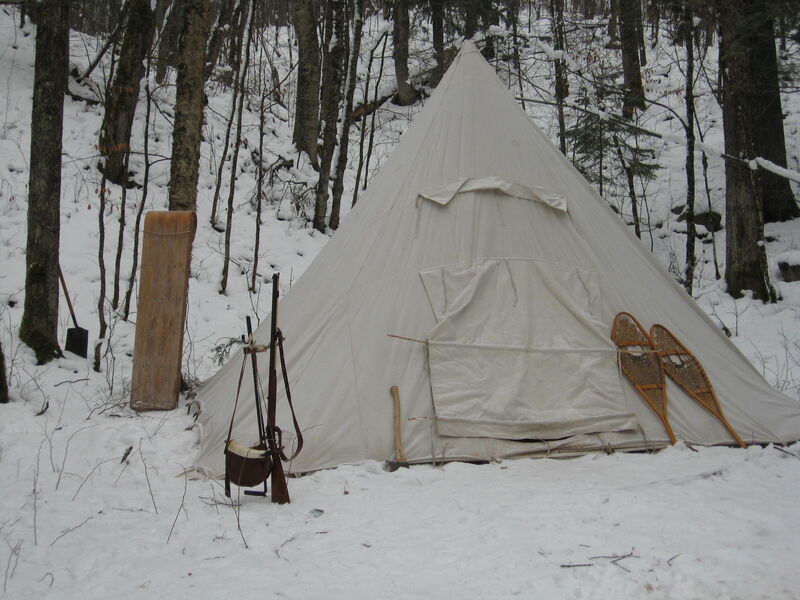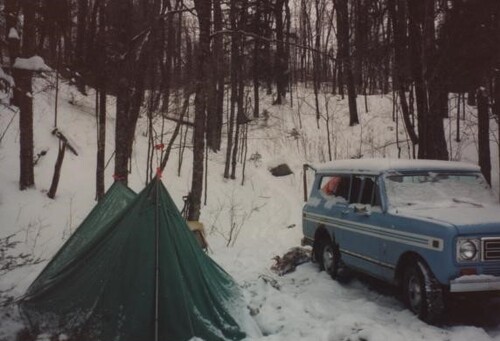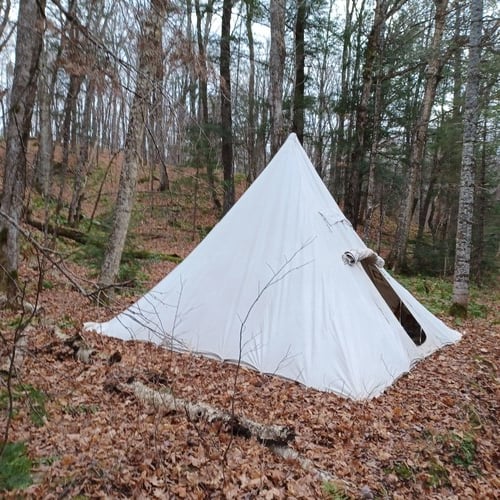
Deer Camp History: Deer Camp 2010. Lots of snow, sleet, and cold made for a deer camp experience that will long be remembered. The deer were scarce this year but adventure was plentiful .
Wisconsin’s deer hunt is one of Wisconsin's most culturally significant annual events. Although the first deer hunting regulations were passed in 1851, modern deer hunting in Wisconsin dates back to 1897 when several developments launched the modern hunting era including requiring hunters to purchase a license, advances in firearm technology, and the beginnings of scientific game management. A resident license cost $1.00 and a nonresident license was $30.00. 12,000 licenses were sold. Since then many styles of hunting and deer camps have evolved as society and technologies changed. Yet the tradition of deer hunting remains strong in this state. One aspect of deer camp is that it is often a family affair with multiple generations participating in deer camp.
In the early years of the 1900s, deer hunting was mostly restricted to Northern Wisconsin since that is where the deer lived. A 1929 population estimate of deer in the state listed the number of deer in Dunn County at 10 deer. Getting to deer camp in this era was a grand adventure. The members of the hunting camp would gather at the house or farm of one of the camp members - often the home of the man who was responsible for organizing the camp. The hunting party would load up a wagon with their camp gear and set off for the nearest railroad station. The hunters would travel by rail up north. After disembarking at one of the many small towns along the railway, the camp would hire a local man to ferry them to the location of their hunting camp. Some hunting parties set up camp in abandoned logging camps, and other parties set up canvas tents. Many tasks had to be accomplished before opening day. In addition to pitching the tents, firewood had to be cut and split, a latrine needed to be dug and a sturdy stick installed over the hole. Camp furniture was made. One veteran hunter would amble off into the woods and bring back a doe or two for camp meat. Whenever the camp cook needed meat for a meal, he would slice hunks of venison off the camp meat deer to feed the hungry hunters. One other important task was to test-fire the rifles to make sure they were still on target. During this time, rifles such as the now venerable Winchester model 1894, shooting 30-30 cartridges using the then-new smokeless powder were just beginning to be available for hunting. The majority of rifles would still be shooting black powder in rounds like 44-40, 45-70 or 38-55 out of a lever action or single shot rifles. Double-barrel shotguns, most likely being used with buckshot, are common in photos from this era. On opening morning, the hunters went through the age-old ritual of getting up well before light and stumbling through the woods to find their favorite spot and beginning the search for a deer. The buck pole was a feature of these early camps with the deer and the occasional bear being displayed for all to see.

Deer Camp History: The Great Halloween Blizzard of 1991 made the following deer season a real adventure. There was 18 inches of snow on the ground when we set up camp, and an additional 18 inches fell during the three days we hunted. I was glad my Dad still had his old Scout. We filled three tags this year.
The season lasted from two to four weeks. After it concluded, the various hunting parties broke camp and hauled their gear back to the railroad stations. With the number of hunters and harvested deer congregating at the train stations, it would have been grand to simply be able to listen to all the hunting tales being told while waiting for the train and on the ride home.
During this era, deer populations were in flux. Market hunting and a rapidly changing environment made being a deer difficult. Several rules were implemented to help the deer population grow, In 1897 a two-deer limit was put in place. A bucks-only season was implemented in 1915. Beginning in 1925, the deer season was closed on odd-numbered years until 1935.
The advent of the automobile transformed deer camp as it did almost all aspects of US society. Gone were the train rides as hunters began driving to their hunting camps. Tar paper shacks and cabins were built to house the members of the hunting party. Motels also began to cater to hunting parties. Other hunters began hunting the newly-formed national, state, and county forests, often setting up tent camps. Automobiles also gave hunters a newfound mobility. The motel hunters could commute to their hunting spot each morning, and if that spot did not seem to hold deer, they could move to a different place. Hunters in a hunting camp on a 40 or 80 acre piece of hunting land could disperse to nearby public land. The automobile also lessened the duties of the camp cook since hunting parties could now venture to the nearest town or tavern for food and a rehydrating adult beverage after a full day in the woods. Local taverns, and other places including churches, especially in the north woods, responded with special hunter’s chili feeds and other events to lure hunters into their establishments.
The firearms carried by hunters also underwent major changes during this time period. Soldiers returning from WWI in Europe began using bolt-action and “autoloading” (semi-auto) rifles. Many new cartridges emerged like the 30-06, 270, and 35 Remington. The old black powder guns faded away. Despite the changes deer camp remained a place where dedicated hunters gathered. Each camp has its own traditions, and was often a multi-generational affair. Some hunting camps have been around for over 50 years and some much more.
The 1950s saw another major change in deer hunting in the state - an expanding deer herd. Deer began to repopulate the southern reaches of the state and by 1960 were present in every county. Many hunters began to hunt much closer to home, or even out of their home. The style of hunting in the southern regions of the state were often very different from “up north” where vast tracks of forest existed. Hunting “up north” is often a solo pursuit with the hunter most commonly either still hunting or stump sitting. Still hunting is the art of walking through the woods as quietly as possible in the hopes of sneaking up on a deer. Stump sitting is where the hunter sits on a stump or log in the hope of ambushing a passing deer. In the south, the tracts of land are often small and consist of private land. Even the public DNR wildlife areas are limited in size. There is often a routine to hunting in the south. I began hunting with my dad in a similar area in Minnesota and the routine went like this. Arise well before first light and get dressed while gulping down a cup of coffee and a piece of toast. Wander out to the stands. (Each hunter had their own place to make a stand. And we did stand in the woods as the modern tree stand had not been invented. A few hunters nailed some rickety steps to a tree and then nailed a few more board across a couple of branches to make a stand.) We stayed in our stands until 9:00 AM when we wandered back to camp, which was an old farmhouse, for a major breakfast. While we were eating breakfast, the experienced hunters would decide where and in what direction we would conduct a drive. We would spend most of the rest of the day doing drives until it was time to head to the stands until dark. Chili was our standard food after a hard day's hunt. Chili is the most common food in both southern and “up north” deer camps. Every camp has a chili cook who takes great pride in making deer camp chili.
From the 1950s to the 1980s deer hunting carried on nicely, but changes were coming. First, in 1980, hunters had to get new clothes as blaze orange was now required when hunting. The number of hunters and deer harvested continued to climb. Many years a new record harvest was set with a few down years scattered in between record years. 1990 saw a peak in license sales with 699,275 licenses sold. Since then license sales have continued to decline. In 2023, 434,817 licenses were sold for gun deer hunting. Despite the decline in the number of hunters in the woods, the number of deer harvested was on par with the number of deer taken in the mid-1980s. The tar paper shacks of the 1940s and 50s were upgraded to cabins with electricity, running water and, gasp!, indoor plumbing. Although I was in one deer camp where they had a thoroughly modern cabin with an outhouse. One old-time member of the camp explained that a real deer camp had to have an outhouse. Using camping trailers and RVs for deer camp also became common starting in the late 1960s. Campers have the advantage of being able to easily move to new hunting areas when all the members of the camp fail to bag a mythical turdy point buck in the old location. Hunters found new ways to move in the woods as the use of ATVs and later UTVs became common. Conversely, hunters have become less mobile during the hunt as the use of tree stands and blinds has become more prevalent. With some of the elevated blinds looking for the perfect deer has never been so comfortable.

Deer Camp History: Deer Camp 2023 was marked by mild weather and an abundance of venison in the freezer. I had to break camp early because I was out of tags.
The deer population has declined a bit from the peak years, but they are still higher than any time in the history of Wisconsin’s modern deer hunt. The hunt still remains a time to reconnect with family and friends. A time to teach new hunters the ins and outs of the hunt. And a time to get out the in the woods and bring home some venison.


Comments
Add new comment